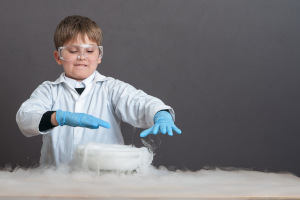Home »
Blog »
Make Back to School Cool: Three Science Experiments Using Dry Ice
Make Back to School Cool: Three Science Experiments Using Dry Ice

It’s back to school time here in Buffalo and Rochester, but that doesn’t mean fun time is over – especially if you have a little dry ice on hand.
Dry ice can be a fun to use in experiments – as long as you handle it safely (see instructions below). It has cool properties (literally) that cause it to fog, make bubbles, and even make noises when used with other objects.
Here are three fun science experiments to try – grab some dry ice and give them a go! But first, some notes on dry ice safety.
Dry Ice Safety
- Dry ice is not a toy! Use it only with adult supervision.
- Dry ice must be handled using heavy gloves or tongs. It will cause severe burns if it comes in contact with bare or unprotected skin.
- Always wear safety goggles when handling dry ice. The debris and shards are extremely dangerous to your eyes. When tapping dry ice with a hammer, first cover it with a towel to keep the pieces in one place.
- Never put dry ice in your mouth.
- Never store dry ice in an airtight container. As the dry ice sublimates, gas pressure will build and the container will explode.
- Do not store dry ice in your freezer. It will cause your freezer to become too cold and the freezer may shut off.
- In the unlikely event of a dry ice burn, treat it the same as you would a heat burn. See a doctor if the skin blisters or comes off.
Project 1: Balloon Blow Up
Materials
- Dry ice
- Empty soda bottle
- Balloon
Instructions
- Put a few small pieces of dry ice into the bottle, then quickly put the opening of the balloon over the mouth of the bottle.
- As dry ice sublimates (turns from a solid to a gas – in this case carbon dioxide), it will blow up the balloon. When the balloon is fully inflated, take it off of the bottle and tie the end.
- Next, blow up another balloon with your breath and tie the end.
- Once both balloons are filled and tied off, throw them both in the air and see which one sinks more quickly to the ground
The Science
Dry ice is not made from water, it’s frozen carbon dioxide (CO2). Unlike ice that you put in drinks, dry ice never becomes a liquid; it turns directly into a gas. Carbon dioxide weighs more than air, so anything filled with it will sink more quickly than the same object filled with air.
Project 2: Screaming Metal
Materials
- Dry ice
- Quarter
- Metal spoon
- Other pieces of metal
Instructions
- Place a piece of dry ice on a flat surface.
- Make sure to wear gloves or use tongs when handling the dry ice.
- Place a towel underneath the dry ice before laying it down; don’t put the dry ice directly on tables or countertops because it could damage them.
- Once the dry ice is in place, put a quarter on top. After a few seconds, the quarter will vibrate and make a squealing sound. You can also try the experiment with a metal spoon, knife, or other flat pieces of metal. Experiment to see what kinds of sounds you can make!
The Science
The metal makes a sound as dry ice sublimate around it; this causes the metal to vibrate very quickly, which makes the sound that you hear.
Project 3: Foggy Gurgling Bubbles
Materials
- Large container
- Dry ice
- Liquid dish soap
- Warm water
- Tongs
Instructions
- Fill a container about halfway full of water. Add a few drops of dish soap, stirring the soap into the water.
- Add a few pieces of dry ice.
- The soap bubbles will have fog in them from the dry ice. The mix will also begin to produce bigger than normal bubbles of soap. As more dry ice sublimates in the water, the bubbles will spill over the container. The mixture will also make a sound similar to water boiling.
The Science
Another cool example of dry ice sublimation!

